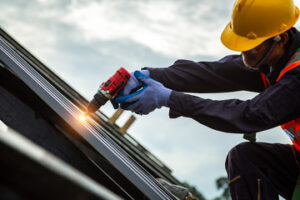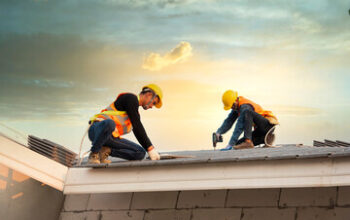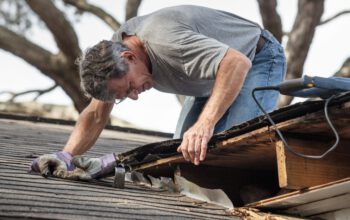Even sturdiest tile roofs eventually require repairs. Recognizing early signs of wear and tear can prevent extensive damage and mitigate interior water intrusion.
Identifying tiles that need replacement requires careful inspection, using a ladder and observing the underlying structure from above. Inspecting a new replacement for defects is also important. Contact Tile Roof Repair Las Vegas for professional help.
Identifying cracks and broken tiles is an essential first step in tile roof repair. This will help you assess the severity of the damage and gather the necessary materials to repair it. The best way to inspect your roof for damage is by walking the length of it. However, you must take the proper safety precautions and use a stable ladder to ensure your safety. Once you have inspected the damage, you should be able to determine whether it is just a simple crack that can be repaired with roofing adhesive or whether the entire tile needs to be replaced.
Extreme heat, freeze-thaw cycles and impact damage can cause your tile roof to develop cracks in some areas. These cracks aren’t a major issue on their own, but they will allow water to penetrate the underlying structure and cause damage. Cracks in your roof should be repaired as soon as you can so that the problem doesn’t worsen.
Another common issue that requires prompt attention is displaced or missing tiles. High winds and severe storms can dislodge tiles from their original position, which leaves the exposed area vulnerable to water infiltration. This can lead to structural damage, mold growth and other health issues. In addition, gaps caused by cracked or missing tiles will force your HVAC system to work harder to maintain indoor temperatures and will result in higher utility bills.
Once you’ve located the affected area, remove any loose tiles and dispose of them properly. You’ll need to be prepared to do some heavy lifting, but a flat pry bar and a hammer are sufficient tools for the task. Be sure to wear safety goggles and protective work gloves to prevent injuries.
After removing any cracked or broken tiles, carefully clean the area and apply roofing sealant to each crack. Ensure that the sealant extends past the edges of the tile for a complete and secure fit. You can also choose to replace the damaged tile entirely if it can be safely done so without damaging other tiles.
When replacing a broken tile, make sure to select a similar one in color and style as the others on your roof. This will prevent future problems from developing by ensuring that all the surrounding tiles are of the same material.
Algae Buildup
If you notice dark green or black stains on your roof, this is a sign that your tiles are infested with algae. This is a common problem in humid environments, and it can be caused by a number of factors. In some cases, it may be the result of clogged gutters, which can cause water to flow over your tile roof instead of down and away from the property. In other cases, it can be the result of a more serious issue like broken tiles or a leaky roof.
In addition to being unsightly, the presence of algae can also damage your roof over time. This is because algae tends to thrive in damp conditions, and it can gradually eat away at your roof tiles. If you notice that your tile roof is covered with algae, it’s important to have it cleaned by a professional.
A professional tile roof cleaner can use gentle cleaning methods to remove algae without damaging your tiles. In addition, they can inspect your roof for signs of more serious problems and recommend any necessary repairs. It’s also important to have your gutters checked regularly to make sure they aren’t blocked by leaves or other debris.
Moss and mildew growth on your roof is another common sign that you need to have it repaired. Both moss and mildew can damage your tiles, and they are also likely to trap moisture on the surface of your roof. This can lead to deterioration over time, and it’s important to address the problem as soon as you notice it.
There are several ways to remove moss and mildew from your roof. You can try to manually scrub away the buildup with a soft brush and a garden hose at low pressure settings, or you can purchase commercial roof cleaning solutions that are safe for your type of roof. In general, you should avoid using a high-pressure washer, as this can cause your roof to crack and break.
Algae, moss, and mildew can all be dangerous for your roof if left untreated. They can hinder your home’s aesthetic appeal, increase energy costs, and encourage the development of other harmful organisms. By scheduling regular inspections and keeping your gutters clean, you can prevent the emergence of these unwanted fungi.
Water Leaks
There are a few common issues that can cause tile roof leaks. First, cracks and holes in tiles should be repaired right away to prevent moisture from seeping into the underlying structure. This can cause extensive damage and lead to water infiltration into your home.
It’s also important to pay attention to any signs of mold or mildew on the roof. These are an indication of excess moisture and must be addressed immediately to avoid structural damage and costly repairs.
Other sources of leaks can include poor installation, damaged underlayment, and clogged gutters and drainage problems. Poor installation may occur due to sloppy workmanship or shortcuts taken during the original installation, which can quickly become a problem. If you have a tile roof that was improperly installed, it is vital to seek professional help from roofing contractors to ensure the proper installation of replacement materials.
Damaged underlayment is another common cause of leaks in tile roofs. This layer sits beneath the tiles and acts as a critical waterproof barrier that can degrade over time due to exposure to heat, moisture, and debris. When this layer degrades, it allows water to penetrate through the tiles and into your home’s interior. Signs of underlayment failure include water stains on ceilings, sagging in the roof, and mold growth.
Lastly, clogged gutters and drainage problems can contribute to leaks in tile roofs. This is because the tiles aren’t shedding moisture properly and it’s collecting in the gutters. This can create a dam that blocks water flow and cause overflows, which in turn leads to leaks.
While it’s possible to repair tile roof leaks on your own, it’s often better to leave the job to professionals with the proper training and tools to ensure a high-quality result that will provide long-term protection for your home. In addition to using proper safety gear, roofing contractors can apply specialized sealants and membranes that create a protective barrier against water infiltration. Keeping up with regular maintenance and conducting periodic inspections are also effective ways to prevent leaks in tile roofs.
Poor Drainage
The tiles used on tile roofs are porous, which means that they can absorb water. This absorption can lead to a variety of issues, including water stains on ceilings and mold or mildew growth. Regular cleaning and treatment can help prevent these problems. If the tiles have started to erode or crack, this is usually a sign that it’s time for a new roof.
Another common problem with tile roofs is that the underlayment can deteriorate over time. The underlayment is the critical waterproof barrier that protects your home from leaks, but if it degrades, then water can easily penetrate through the tiles and into your home. Replacing the underlayment is a critical step in tile roof repair.
Faulty flashing is another common cause of leaking tile roofs. If the flashing is not installed properly or becomes damaged over time, it can allow water to seep into the plywood base of your roof. This can cause structural damage to your roof and leaks in your home.
Loose ridge tiles are another common issue that should be repaired as soon as possible to prevent further deterioration and potential water infiltration. These loose tiles are easy to identify, as they typically have a gap or appear slightly out of alignment with the surrounding tiles. Loose ridge tiles can be fixed by applying a strong adhesive or mortar to the underside of the tile and pressing it firmly into place. It’s important to use a roof tile that matches the color and style of your existing tiles for a seamless appearance.
Finally, pay close attention to the areas around vents, chimneys, and skylights for any signs of leakage or corrosion. These areas are often the source of leaks in tile roofs due to the additional gaps and seams needed to accommodate these fixtures. Regularly inspect and clean the gutters to ensure they are clear of debris and functioning properly.
While there are some steps you can take to maintain your tile roof and avoid costly repairs, it’s always best to consult a professional roofing contractor when addressing any major problems with your tile roof. Professional roofers have access to specialized tools and materials, which can speed up the repair process and ensure that all repairs are done correctly. They also have the experience and expertise to diagnose underlying structural problems that may require further repair or replacement.


